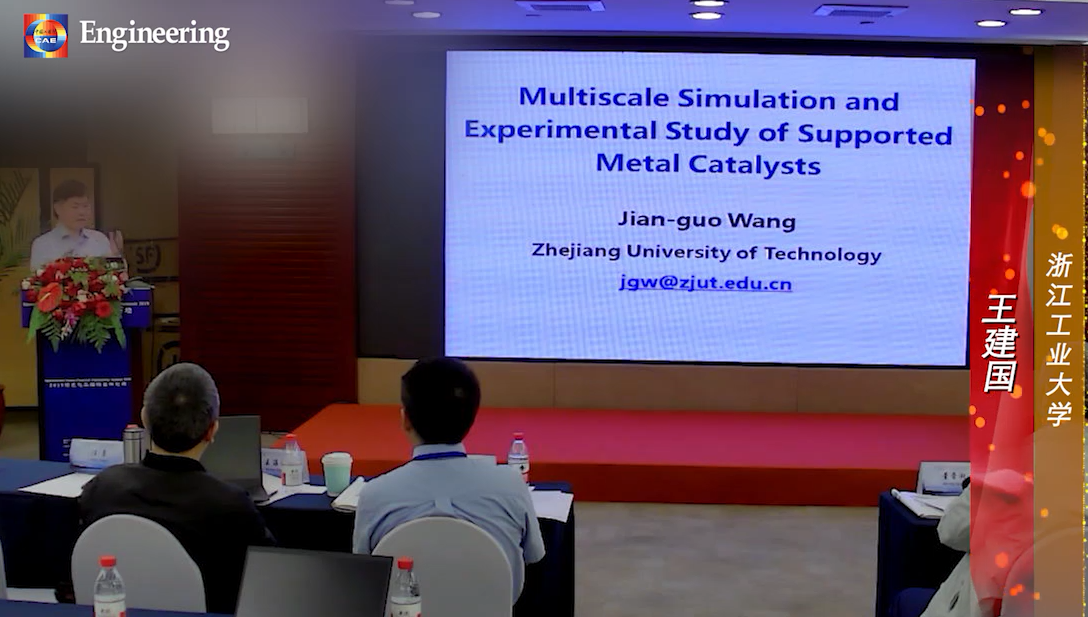Search scope:
排序: Display mode:
Frontiers of Chemical Science and Engineering 2023, Volume 17, Issue 9, Pages 1289-1300 doi: 10.1007/s11705-023-2299-7
Keywords: biowaste chitin nanofibrous palladium nano-catalyst catalysis
Yali CHEN,Lu XIONG,Weikang WANG,Xing ZHANG,Hanqing YU
Frontiers of Environmental Science & Engineering 2015, Volume 9, Issue 5, Pages 897-904 doi: 10.1007/s11783-015-0782-1
Keywords: nitrobenzene nano-structured Cu electro-reduction voltage-dependent electrodeposition high selectivity
Enhanced methanation stability of nano-sized MoS
Zhenhua LI, Jia HE, Haiyang WANG, Baowei WANG, Xinbin MA
Frontiers of Chemical Science and Engineering 2015, Volume 9, Issue 1, Pages 33-39 doi: 10.1007/s11705-014-1446-6
Keywords: unsupported catalyst molybdenum sulfide stability alumina methanation

Wang Jianguo: Multi Scale Simulation of Supported Nano Catalyst (2019.5.25)
22 Apr 2021
Keywords: 绿色化工
Water-dispersible nano-pollutions reshape microbial metabolism in type-specific manners: A metabolic
Frontiers of Environmental Science & Engineering 2022, Volume 16, Issue 9, doi: 10.1007/s11783-022-1548-1
• Water-dispersible nano-pollutions exhibit type-specific toxic effects
Keywords: Nano-toxicity Nano-plastics Quantum dots Microbial metabolite Metabolic dysregulation
Yunge WEI; Jiayu WANG; Ruoyu LI; Ling XU; Feipeng XIAO
Frontiers of Structural and Civil Engineering 2022, Volume 16, Issue 11, Pages 1474-1485 doi: 10.1007/s11709-022-0869-2
Keywords: nano-cellulose emulsified asphalt binder dispersion rheological properties Fourier transform infrared
Frontiers of Environmental Science & Engineering 2021, Volume 15, Issue 5, doi: 10.1007/s11783-021-1388-4
• Biochar enhanced the mobility and stability of zero-valent iron nanoparticles.
Keywords: Nano zero-valent iron Biochar BDE209 Transport Soil
Immunological effects of nano-enabled hyperthermia for solid tumors: opportunity and challenge
Frontiers of Chemical Science and Engineering 2022, Volume 16, Issue 3, Pages 333-344 doi: 10.1007/s11705-021-2059-5
Keywords: nano-enabled hyperthermia immunogenic cell death heterogeneous immunological landscape tumor microenvironment
Modeling nanostructured catalyst layer in PEMFC and catalyst utilization
Jiejing ZHANG, Pengzhen CAO, Li XU, Yuxin WANG
Frontiers of Chemical Science and Engineering 2011, Volume 5, Issue 3, Pages 297-302 doi: 10.1007/s11705-011-1201-1
Keywords: catalyst layer PEM fuel cell lattice model Monte Carlo method catalyst utilization
Behavior of aqueous stable colloidal nano-C
Jing HUO,Ye YU,Ling GE,Bo ZHANG,Yiliang HE
Frontiers of Environmental Science & Engineering 2015, Volume 9, Issue 2, Pages 197-205 doi: 10.1007/s11783-014-0624-6
Keywords: nano-C60 (nC60) aggregates photochemical reactivity artificial biological membrane
Frontiers of Mechanical Engineering 2023, Volume 18, Issue 1, doi: 10.1007/s11465-022-0720-4
Keywords: milling force nanofluid minimum quantity lubrication aerospace aluminum alloy nano biological lubricant
Nano-measuring Instruments and Nano-machining Technology
Yao Junen
Strategic Study of CAE 2003, Volume 5, Issue 1, Pages 33-37
Keywords: nanotechnology nano-measurement nano-machining electron microscope scanning probe microscope focused
Oxidant or catalyst for oxidation?
Jianzhi Huang, Huichun Zhang
Frontiers of Environmental Science & Engineering 2019, Volume 13, Issue 5, doi: 10.1007/s11783-019-1158-8
Keywords: Peroxymonosulfate Manganese oxides Catalyst Oxidant
Monte Carlo simulation of the PEMFC catalyst layer
WANG Hongxing, CAO Pengzhen, WANG Yuxin
Frontiers of Chemical Science and Engineering 2007, Volume 1, Issue 2, Pages 146-150 doi: 10.1007/s11705-007-0027-3
Keywords: catalyst utilization PEMFC commercialization Pt/C catalyst conduction
Frontiers of Chemical Science and Engineering 2022, Volume 16, Issue 8, Pages 1268-1280 doi: 10.1007/s11705-022-2143-5
Keywords: atomization nonsolvent induced phase separation bicontinuous porous structure micro-nano composite
Title Author Date Type Operation
Pd nano-catalyst supported on biowaste-derived porous nanofibrous carbon microspheres for efficient catalysis
Journal Article
Efficient and selective electro-reduction of nitrobenzene by the nano-structured Cu catalyst prepared
Yali CHEN,Lu XIONG,Weikang WANG,Xing ZHANG,Hanqing YU
Journal Article
Enhanced methanation stability of nano-sized MoS
Zhenhua LI, Jia HE, Haiyang WANG, Baowei WANG, Xinbin MA
Journal Article
Wang Jianguo: Multi Scale Simulation of Supported Nano Catalyst (2019.5.25)
22 Apr 2021
Conference Videos
Water-dispersible nano-pollutions reshape microbial metabolism in type-specific manners: A metabolic
Journal Article
Laboratory investigation of emulsified asphalt binder modified with wood-derived nano-cellulose and nano
Yunge WEI; Jiayu WANG; Ruoyu LI; Ling XU; Feipeng XIAO
Journal Article
Effects of different types of biochar on the properties and reactivity of nano zero-valent iron in soil
Journal Article
Immunological effects of nano-enabled hyperthermia for solid tumors: opportunity and challenge
Journal Article
Modeling nanostructured catalyst layer in PEMFC and catalyst utilization
Jiejing ZHANG, Pengzhen CAO, Li XU, Yuxin WANG
Journal Article
Behavior of aqueous stable colloidal nano-C
Jing HUO,Ye YU,Ling GE,Bo ZHANG,Yiliang HE
Journal Article
Mechanical behavior and semiempirical force model of aerospace aluminum alloy milling using nano biological
Journal Article
Monte Carlo simulation of the PEMFC catalyst layer
WANG Hongxing, CAO Pengzhen, WANG Yuxin
Journal Article








